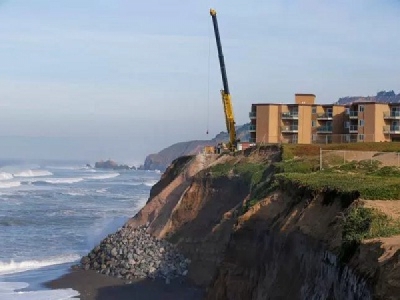
Posted on January 30, 2017
By Aaron Kinney, The Mercury News
The U.S. Army Corps of Engineers will study long-term fixes to three areas of Pacifica that have been hammered by powerful winter storms, officials announced Wednesday.
The analysis is a key first step in a process that could result in the agency performing upward of $6.2 million in repairs, with the federal government paying for much of the work, said City Manager Lorie Tinfow.
“We’re so happy that we finally have something good to say about all our emergency responses,” she said. “Help is coming our way.”
Last winter’s potent El Niño storms wreaked havoc on the coastal city, damaging Pacifica Pier and a nearby section of the Beach Boulevard sea wall and promenade, chewing away the earth and concrete surrounding a 6-foot-wide storm drainage pipe known as the Milagra watershed outfall, and forcing the evacuation of a clifftop apartment complex at 310 Esplanade Ave.
This winter the Pacifica Ocean has hurled more surging waves into the fragile coast. In December, a massive sinkhole opened up on a trail leading down to the beach just north of 310 Esplanade, which is now scheduled for demolition.
After declaring a state of local emergency in January 2016, the city secured enough money last year to begin repairing some of the damage, but still needs millions more.
“It’s critical for Pacifica’s long-term survivability not to have this erosion eating away at their community,” said Rep. Jackie Speier, D-Hillsborough, who joined city, state and federal officials Wednesday at a news conference.
Officials said Wednesday they have made significant progress in securing money for 12 damaged sites. Two projects — bluff reinforcement near 310 Esplanade and the removal of two private homes farther south — are in consideration for the state’s federally funded Hazard Mitigation Grant Program.
The city also expects to receive about $1 million through the California Disaster Assistance Act and $2 million from its insurance company.
The Army Corps will conduct a three- to four-month study to determine whether three projects — the 300 block of Esplanade, Beach Boulevard, and the Milagra outfall — are of “federal interest.” If the projects meet that threshold, the Army Corps will spend about 18 months conducting a feasibility study, after which the agency would decide whether to embark on design and construction, according to Tinfow.
The federal government would pick up half the cost of the feasibility study and 65 percent of planning and construction.
“The projects we’ve submitted are so large in scale and cost that we know we need help,” said Tinfow. “They have the resources to bring to bear to help us.”
Meanwhile, construction crews are almost done removing asbestos and other potential hazardous materials from inside 310 Esplanade. Once that work is complete, crews will begin demolishing the structure. Tinfow said the city likely will make an announcement in coming days.
Source: The Mercury News





